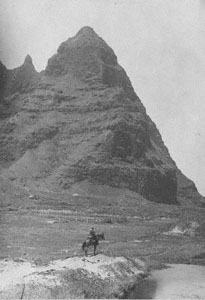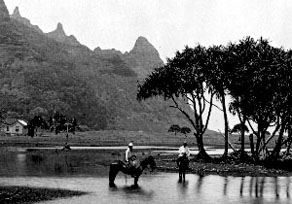 |
 |
 |
|||||
|
|
|
|
|
|
|
|
|
|
|
|||||||
| |
|
An unidentified rider stands before Makana. Photo courtesy of the Bishop Museum.
|
Until the mid 20th Century, horses played an essential role in Ha‘ena. Long-time residents such as Samson Mahuiki recall the days when "everybody ride horse." Given the rugged terrain, especially on the trail from Ha‘ena to Kalalau, one might not have expected that horses would have been so useful. Samson explains the methods of managing horses on that tortuous trail, and the method of sending produce back and forth between Kalalau and Ha‘ena: "On the Kalalau trail, the only place we walk was just before you reach reach Hololo big stone, the rocks are so small, sometimes kind of slippery. But the horse can usually walk on the edge, that's where there's the best footing. So my old man told me, whatever the horse do, you give him free rein, make sure the bridle is free, and you open your leg from the right stirrup, in case you fall over. So you just ride in like that, and let the horse just take over."
|
|
|
|
"My uncle Simon used to tell us all where the rest stops on the trail, when they used to come out and go back and forth. All I know is, my dad and my uncle, when I was still young, if they went Kalalau... I know one time I went down there where Gordie used to live, and two horses were there. They were planning to go in. And my dad used to always tell us, when you had people in there, you take in what you get and you get Kalalau horses. So if you like to send out something, you put it on the Ha‘ena horse. But if you went in, and you have to send something out, or when these people have to send something out, they just put it on the other horse, Ha‘ena horse, and let them go, and he works his way out. And then the same thing you do, you take Kalalau horse, when you come home, you like send something, just put it on, he go back home. "I tell you when I was young, I used to work taro from end of the road, that's where my uncle Kalei was, and then my uncle Jacob had the poi mill. So that's all what he did. He had this stallion, and they put me on top. But the horse did everything, I didn't do nothing. They load me up, they load the taro and put me on, regular saddle with full bag--like 100-pound bag of taro--on top, just throw them on the horse, put me on. And when they unload over in Kalalau, I come ride right by the window, right by the kitchen, the old lady see you they come out, pull me off, huli the bag, put me back, I take the horse back."
|
||
|
|
||
Carlos remembers Samson in a much more active capacity as a horseman: "Before they had helicopters on this island, he used to do all the rescues on the Na Pali coast. He used to ride his horse down the coast, and I saw him one time, in the middle of the night--black ,stormy, rainy night--get on his horse and go down the Kalalau trail to go get somebody who was in trouble." Under the circumstances of the Hui Ku‘ai ‘Aina, the land in Ha‘ena was open range and residents let their livestock roam freely. Samson states, "In Limahuli, we had cows EVERYWHERE -- to the side here, to the top where you cannot go. Every trail in there we used to walk." Not only Ha‘ena, but the neighboring valley of Hanakapi‘ai and down in Kalalau. Samson used to drive cattle (pipi, "beef") on the Kalalau trail. Here are some of his stories:
|
||
|
|
||
"I drove pipi out of Hanakapi‘ai. In Kalalau they used to have the sampans, I don't know what you call them -- the WWII landing craft. That's how they used to bring the cattle out. From Honokoa, they used to lead the cows to Kalalau, that's what they'd do. With our kind thinking, to lead out cows -- easy. How I did mine is, I took the cow in heat, I took em in. Wild, the cows were, wild. Came out of Ha‘ena, they went up the cave and stayed--that nice cave, all that guava--they went up to the top and hid in there. That was something! I went in at night, they were all down with the cows. I take cows out there with the calves, and I catch tie 'em up, chase all the cows, mix 'em up, they come straight home. Went right in the corral."
|
|
"The cops were fining us for stray cattle on the road, so I throw all mine on the trail, everybody going. Got them on the trail. Then six went missing. Well they went in to Hanakapi‘ai , and gave birth and everything else, and I never knew. I figured they fell over, because I never could track them going in. Until one year, Kaipo and I were going in with Rex Glasier, I think, right where you cross Hanakapi‘ai and start to zigzag, I saw the ti leaf eaten little bit further inside than the trail. Oh, that caught my eye! I look around, "ehh, little bit more," I came back, I went ride straight inside there. Saw more eaten up, figure "oh, that's cows." The next day I went back in, walk slowly all over, try to find them.... "Fat, fat they were! And then I notice, "oh, strange colors!" Those guys were in there, anyway they were all nice, but they had some strange ones that were born in there, this bull who was born in there too! That's how long the cows ran away, stayed in, and they gave birth, and these guys I never know -- no idea."
|
||
|
|
||
Days of Plenty:
Given that land was shifting out of the hands of the old-time Ha‘ena residents and into the hands of outsiders with summer homes, Ha‘ena was declining as a place where Hawaiians lived and worked the land. Among the residents there was generally only one mechanical taro grinder in operation to produce poi at any given time. "Always this was all belt," Samson says, "on what we call Model T wheel, with all the big belts. I don't see those grinders no more, the kind that used to grind taro. Now they got, what, plate kind." Samson recalls, "Kila's house where the poi grinder, whatever, for poi. But that is during the early times I think they must have used all that. I think that would be early '30s." His uncle Jacob also had a poi mill: "Jacob's one was going strong until 1946 tidal wave. Then tidal wave, and then it jam up, wipe out everything. Pau." "I don't think they had two going, because, never had that much people in that area already. Never had much people down there that area. Only my uncle Kalei was living down there. Yeah, he was the last down that area. And only during these times that place was kinda filled, all that lo'is over there, those being farmed but not all by him, by my uncle them too, but not for home use....Then when Kila went out, Hashimoto them then kind of moved in all that area. And they were using that, no problem. Because everybody took different areas. So much--you always get the supply of the river. So you could take what you like, and there's not problem there. But this is ideal, eh? You can take only what you need, never had no problem, and was easy to take what you need."
|
||
|
|
||
Two disasters struck Ha‘ena in the middle of the 20th century. These tsunamis changed the nature of Ha‘ena.
|
||
|
|
||
| |
| |
|
|
 |
| Ha'ena Home | Map Library | Site Map | Hawaiian Islands Home | Pacific Worlds Home |

|
|||
| Copyright 2001 Pacific Worlds & Associates • Usage Policy • Webmaster |
|||





